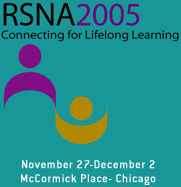
Abstract Archives of the RSNA, 2005
SSK06-02
Contrast Enhancement Patterns in Benign Liver Tumors Insonated after Microbubble Contrast Agent Injection: Comparison of Diagnostic Performance of Baseline and Contrast-enhanced US in the Histotype Diagnosis
Scientific Papers
Presented on November 30, 2005
Presented as part of SSK06: ISP: Ultrasound (Liver: Contrast)
Emilio Quaia MD, Presenter: Nothing to Disclose
Tommaso Vincenzo Bartolotta, Abstract Co-Author: Nothing to Disclose
Massimo Midiri, Abstract Co-Author: Nothing to Disclose
Alessandro Palumbo, Abstract Co-Author: Nothing to Disclose
Stefania Gava MD, Abstract Co-Author: Nothing to Disclose
Maria Assunta Cova MD, Abstract Co-Author: Nothing to Disclose
To assess whether contrast-enhanced US may improve diagnostic performance in benign liver tumors characterization in comparison to baseline US.
306 liver tumors (150 hemangiomas, 65 focal nodular hyperplasias, 15 hepatocellular adenomas, 62 regenerative/dysplastic nodules -RN/DN-, 12 focal fatty sparing/changes, 1 solitary necrotic nodule and 1 intrahepatic extramedullary hematopoiesis), proved as benign by histology (n=223) or multimodality imaging (n=83), were identified in 275 consecutive patients (173 male and 102 female; age: 57 ± 13 years). Benign tumors were identified simultaneously (n=52) or not (n=254) with liver malignancies. Each tumor was scanned by low transmit power after sulfur hexafluoride-filled microbubbles injection at arterial (10-35 secs), portal (50-90 secs) and late phase (90-300 secs from injection). Two readers, blinded to patients clinical data except for presence of liver cirrhosis, reviewed off-site digital cine-clips and classified benign tumoral histotypes according to reference criteria.
Liver hemangiomas revealed nodular peripheral enhancement with progressive fill-in (n=115), or diffuse (n=10) or absent (n=25) enhancement. Focal nodular hyperplasias revealed central spoke-wheel shaped (n=31), or diffuse (n=34) enhancement also with evidence of central hypovascular scar in 18 cases at late phase. Hepatocellular adenomas revealed diffuse homogeneous (n=7) or heterogeneous (n=8) enhancement at arterial phase, with iso (n=4) or hypovascular (n=11) appearance to adjacent liver at late phase. RN/DN nodules revealed diffuse (n=23), absent (n=15) or dotted (n=24) enhancement with isovascular appearance at late phase. Focal fatty sparing/changes revealed homogeneous enhancement with isovascular appearance at late phase. Solitary necrotic nodule and intrahepatic extramedullary hematopoiesis revealed respectively absent and diffuse contrast enhancement. Baseline scan revealed a lower diagnostic accuracy than contrast-enhanced US (15-35% vs 45-95% according to different histotypes; p < .05; McNemar test).
Contrast-enhanced US improved diagnostic performance in characterization of benign focal liver tumors compared to baseline US.
Quaia, E,
Bartolotta, T,
Midiri, M,
Palumbo, A,
Gava, S,
Cova, M,
Contrast Enhancement Patterns in Benign Liver Tumors Insonated after Microbubble Contrast Agent Injection: Comparison of Diagnostic Performance of Baseline and Contrast-enhanced US in the Histotype Diagnosis. Radiological Society of North America 2005 Scientific Assembly and Annual Meeting, November 27 - December 2, 2005 ,Chicago IL.
http://archive.rsna.org/2005/4406034.html

